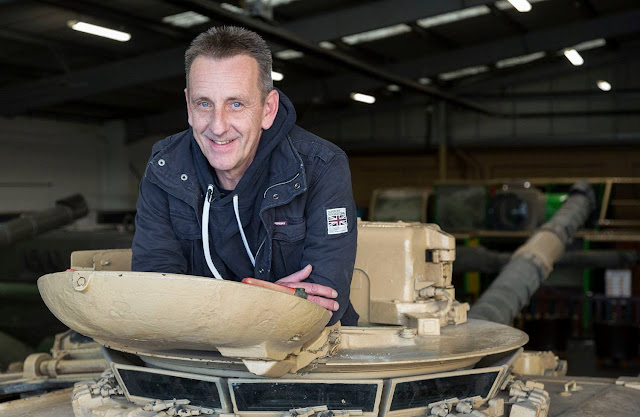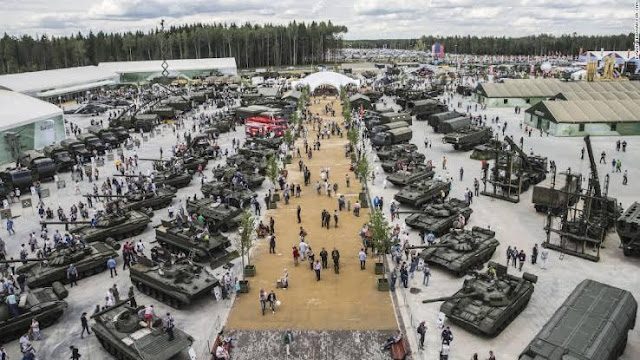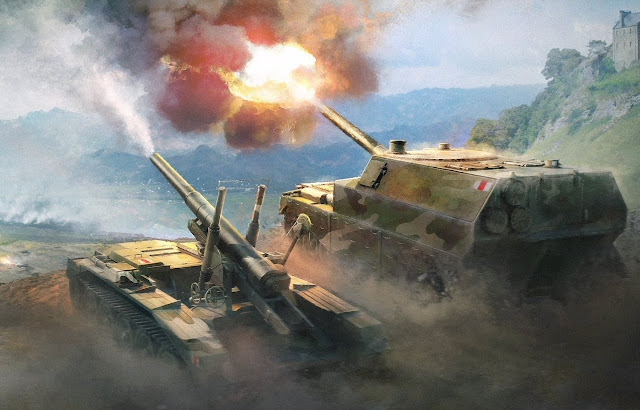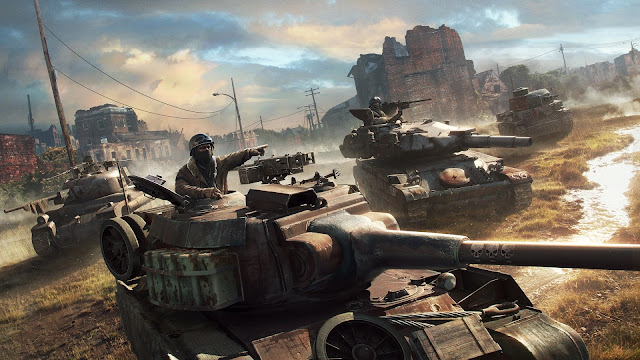Interview by Matt S.
“Those that cannot remember the past are condemned to repeat it,” so the popular truism goes, and traditionally it has been the role of the arts to preserve history and make it palatable to the next generation – thus providing that source of collective “memory” across time. With video games being the most popular form of both entertainment and artistic expression today (particularly for the younger generations) we are increasingly looking to video games to also play a role in that recital of history and to inspire people to learn.
Indeed, it is more critical than ever that there is a mainstream source of learning around modern military history. The younger generations are the first to lack direct access to stories of WW1 and WW2 since those wars occurred. Where millennials grew up with grandparents that fought in the war, the last few veterans are deep into their twilight years, and so we are now almost entirely reliant on second-hand sources of information to understand the totality of those monumentally horrific conflicts. I personally remember my grandfather telling me of his time fighting in the Pacific War. Those stories were shocking to me as a youngester, but also formative in my view on war, and though there has been conflict (and thus, veterans) since, World War 2 occupies a particularly elevated position in our modern culture and understanding of the risks and impact of war. In other words, it needs to be remembered. Not glorified, nor turned into revisionist propaganda. World War 2 needs to be remembered as it was.
The problem is that many video games are poor at picking up that particular baton and serving responsible historical learnings to the younger generations. Worse, many are guilty of deliberately misleading about the history for ideological purposes. It’s literal propaganda in the service of “entertainment”. What’s particularly galling is that we are not just talking about the small niche projects here. We are talking about some of the biggest properties of all.
There are others that try, though. Wargaming – owners of the World of Tanks property (among others) is keenly aware of its social responsibilities, and approaches the way that it addresses war with an abundance of caution.
Having now celebrated its 10th anniversary, World of Tanks has become one of the biggest and most enduring properties that is rooted in history. With fans the world over, World of Tanks is available on just about every platform (including, as of this past week via World of Tanks Blitz, the Nintendo Switch), and given its leadership position, I was keen on exploring what Wargaming, does consider to be its socio-cultural role in informing, educating, and guiding its players to an understanding of the conflicts that it abstracts.
 |
| Richard Cutland |
“I come from an armed forces background,” Wargaming Head of Military Relations, Europe, Richard Cutland said (Cutland served with the Royal Tank regiment within the UK military for 30 years). “So I’ve experienced conflict first-hand. I’ve been involved in conflict. I’ve also got a very young family. And so I have a strong personal feeling towards the topic. I do believe that that World of Tanks, as a game, is removed from the discussion because we concentrate purely on the engineering and mechanical side of the vehicles.
“But putting that aside for a moment, if you were to ask me would I let my children play some of these games based on war? The simple answer is, no. And when I was offered a job with Wargaming, bar absolutely no other question, the one question that was in my mind was whether I wanted to work for a company which is involved in this sort of area. I’ve lost friends in conflicts. I have attended far too many military funerals. But funny enough, when I spoke to my friends and other veterans, I’ve never once had anybody say anything derogatory about any of these games.
“So for example, I once spent over an hour talking to a man who actually commanded a Sherman tank on D-day, and it was a fascinating conversation. What I found particularly noteworthy was that there was nothing negative at all about the game… or any other military shooter. It was just about how he feels we could improve things to make them more realistic.”
And that’s when Cutland turned it around to ask me a question: “If we were to completely get rid of some of these other games, are we not hiding from the horror of war?”
For all my criticisms of some narrative-driven war games out there, this is a perspective I completely agree with. I’ll criticise those games where they deserve it, but I will also always stop short at suggesting that should not be made. It’s only in having them made that we can open a discussion around them, thus fulfilling their role as works of art, and that’s a perspective Cutland shares.
“For me these games – all these games – are a way of getting young people interested in history, and that’s an educational opportunity. I agree the gratuitous violence and glorification of war is not fantastic, but it is at least a way of getting the compass out there so people are aware that these events happened,” Cutland said.
For its part, Wargaming does aim to “point people in the right direction,” as Cutland puts it. Fully aware that Wargaming’s property isn’t a statement of historical record so much as a virtual museum of tanks, the company is heavily invested in encouraging people to visit museums and learn more around the context surrounding the tanks. These efforts have resonated. The company even went as far as to survey its community, and in Australia and New Zealand, discovered that its core player base identified as being passionate about history ahead of video games.
“I personally get 20 to 30 emails from players a day, asking things about different types of armour, armour thickness, the role of each tank in different conflicts,” Cutland said. “So, it’s certainly a massive proportion of our global player base that is interested in history to one degree or another.
“I’ve seen the impact that it can have on a personal level, too. My son absolutely hated history. He found it dull and monotonous – little more than facts and figures. So, we started playing World of Tanks together, and it sparked an interest in him, simply because it was such sheer fun. From there we visited a couple of museums, and then he started to get very interested in the machinery and the technological side of everything. From there, there was a natural progression to find out about conflict, the people that served in them and the horrors of war as well.”
“Nobody is trying to hide any of this. It’s just a question on how to get the players invested in it.”
Wargaming has also made sure that it’s contributing to the real-world discourse around war and the impact that it has. For example, it has long partnered closely with War Child, a charity that assists those children that have experienced conflict areas. “You can probably imagine that first meeting was a very long one about due diligence,” Cutland said. “You would not think that a company called ‘Wargaming’ would be a great fit for a charity called ‘War Child’, but we are celebrating these engineering monstrosities in our games in part because we want people to be interested in their history. And so, we have got a big and highly engaged community, so we have always felt the responsibility to give back in a meaningful way.”
Building authenticity into video games
Cutland described the process whereby a tank is designed into World of Tanks, and it’s truly impressive how much work goes into it, to build and then abstract it to the point where the game doesn’t feel like a dry simulation, but also adequately measures the performance of the tank on the battlefield.
“There are two parts to the development side of it, to simplify the process right down,” Cutland started. “You’ve got the graphics and you’ve got the balance. So first, the design team, along with the historical consultants and a multitude of other people begins work on preparing the potential vehicles.
“Now as I’m sure you can imagine, the game’s been out for ten years, so we’re reaching a stage with the game where it is becoming increasingly difficult to find new and interesting vehicles to put into the game. Sometimes it does turn out to be straightforward. The Swedish tech tree was a very straightforward tech tree, for example. But at other times it’s not so simple. It’s not just about designing each vehicle, it’s also about whether the tank can be upgraded or have different turrets? Can it fit nicely into the game? That’s the first stage we’re trying to identify a potential fit to the game.
“Then the next stage is documentation. This involves archives, blueprints, sketches, military photographs, newsreels, 3D scans where possible. For vehicles that still exist in the world it’s easy, but obviously, we start to have an issue when we start talking about vehicles that either no longer exist, i.e., there’s no real-world copy, or they never moved beyond prototype stage… and we do have a few prototypes in the game as well. That becomes much more complicated at that stage. There we then have to rely on anything at all we can get our hands on and rely on the expertise of the design team to actually produce sketches and turn it into something, which we can actually use again.
 |
| Arsenalen Tank Museum, Sweden |
“We then get designers to build what we call a historical description. We detail tactical and technical characteristics all about the weaponry, including the elevation and depression angles, and armour thickness is obviously incredibly important. We also get data on maximum speeds, but not just maximum speeds as what you’d see on a source like Wikipedia. They’re the maximum speeds on various terrains.
“Only after all of that provisional work is done do we then move onto the next stage, which is the tech tree stage. And then it gets a bit more game-orientated. It is then sent off to test these technical characteristics and address the balance. Balance is, of course, a challenge because we are talking about a game which has got tanks, which very possibly never fought against each other on the battlefield. So, to make sure that nothing is overpowered, or alternatively underwhelming, we test heavily to ensure playability of it in the game.
“And then only after all of that is done, the vehicle’s then given its finalised look. It then goes into internal testing. And once all that’s done again, the vehicle’s ultimately released.”
This process can vary wildly in terms of how long it takes. The easiest tanks might be able to be completed and dropped into the game in as few as four weeks, or it could take upwards of six months if the details on the tank are scarce. To assist in its research, Wargaming maintains partnerships with tank museums across the globe, and this process involves the multiple teams across the organisation, from the dedicated researchers that Wargaming keeps on staff right through to the programmers and testers.
The future for World of Tanks
Ten years of on-going development and support for any game property is a massive achievement, and World of Tanks is still going strong. I couldn’t help but wonder at what might be next though. Wargaming has the world’s biggest virtual museum of tanks, a deeply engaged community with an interest in history, and the capacity and resources for research that dwarfs what almost any other company could draw on.
 |
| Patriot Park, Moscow, has one of the biggest collections of tanks on the planet |
Has there ever been the temptation to take all of that and produce a narrative-driven game? World of Tanks is filled with emergent storytelling but has never built an explicit narrative into the experience. It would be difficult to do, given the developer’s stance to avoid engaging in the discourse around war beyond the engineering, but nonetheless, this would be one way to continue building the World of Tanks brand.
“The natural progression for us is to spark an interest in history and as I’ve said before, leave that in-depth education to the experts with our partnerships with museum operators and so on,” Cutland said.
“The ability of a family of all ages to enjoy the game is core to our success with it, and to actually introduce a narrative would risk compromising that. Don’t get me wrong – I think many of us would love to do a more narrative-driven experience, but I think you would find that it certainly wouldn’t be World of Tanks anymore. It would be something else. It would certainly drive new conversations and thinking, and I do think that would be a good thing. But weighing that up with the fun and playability factor of what we’ve specifically set out to do with World of Tanks… it might not work out well for us.”
I have often argued for the educational value of video games that depict history. My love of Japanese history had its genesis in a Samurai Warriors game. My love of history, in general, came from many late nights playing Civilization 2 as a child. These games must be fun, else they can’t inspire. What’s equally important, though is that the developers don’t just leave it at “fun.” It’s important that they then make sure to take it on themselves to help guide their fans towards learning something about the real history once their appetites have been whet. World of Tanks may well be the most successful example of this in video games to date.
– Matt S.
Editor-in-Chief
Find me on Twitter: @mattsainsb








